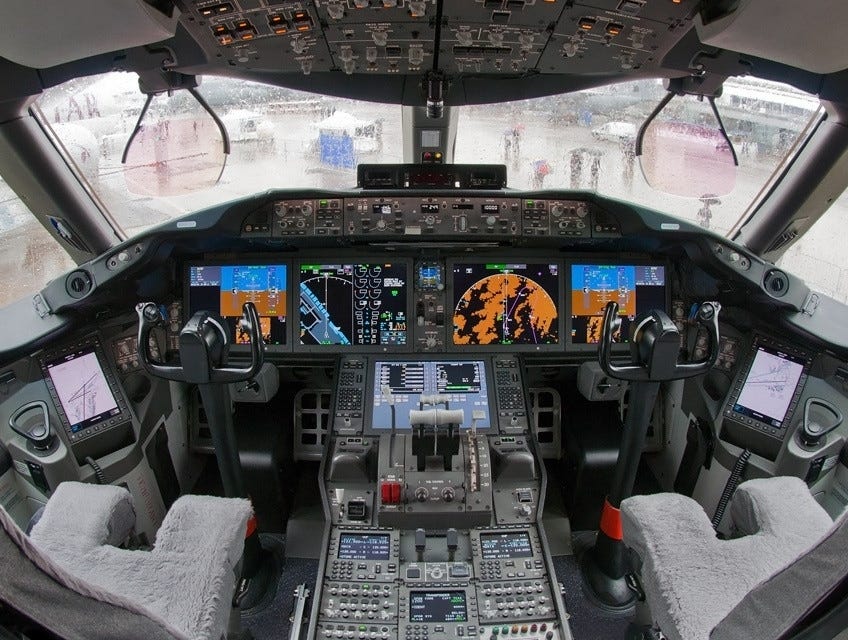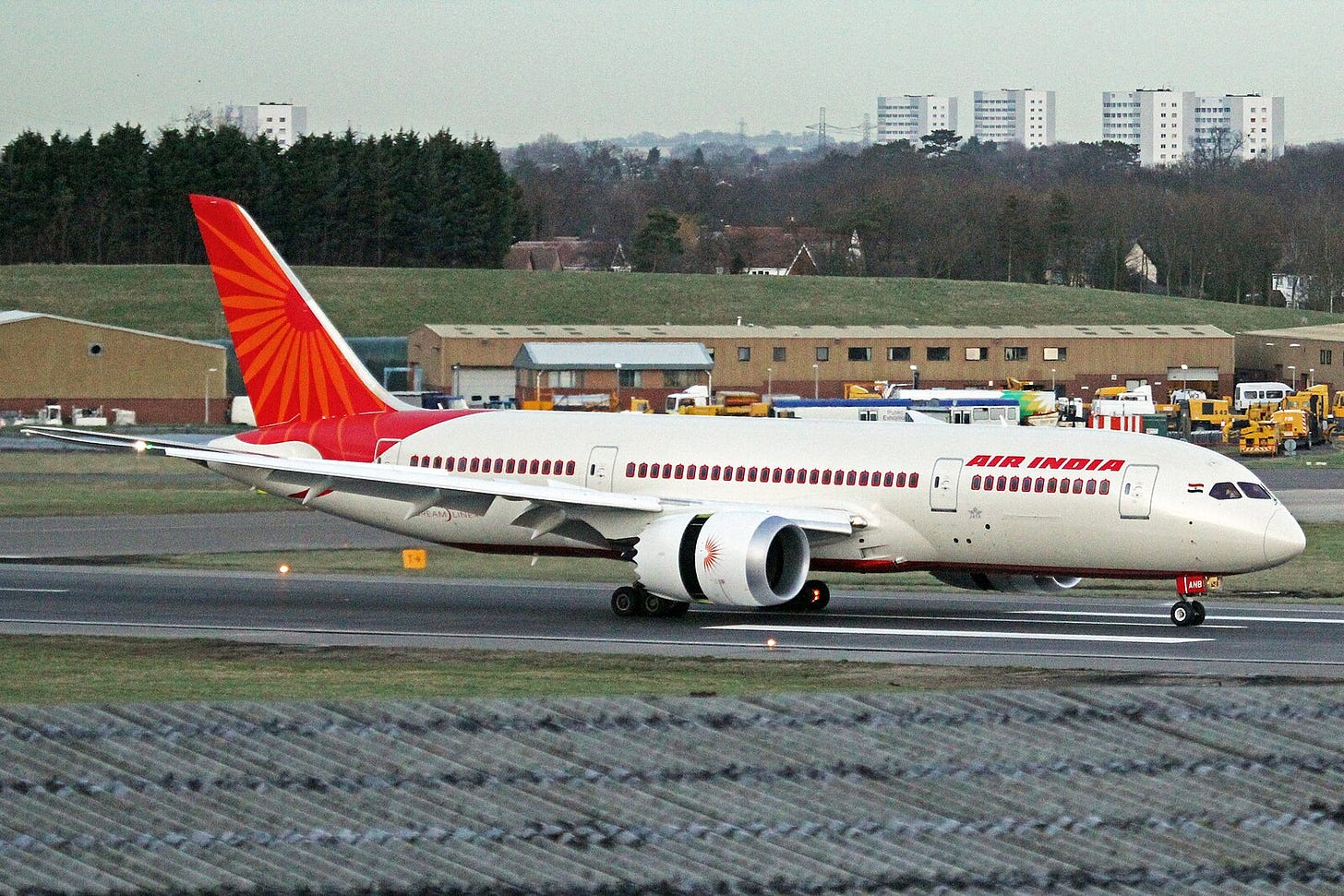The last place without cameras
In an age of total surveillance, cockpits are the final holdout
How could a Boeing 787 — one of the most advanced commercial jets in existence — fall out of the sky just seconds after takeoff? Air India Flight 171 had barely come to a stop before bored and bad-faith actors, bolstered by AI slop, began spouting theories. Such is the modern content economy, where views and clicks must be harvested at all times.
Perhaps the wing slats and flaps — crucial to provide lift at low speeds — were not properly extended. Or the jet fuel was contaminated. Or there was an electrical issue (a previous flight showed Air India’s famously unreliable entertainment systems were inoperable). Or it was another Boeing build quality issue, following the well-documented problems with the 737 MAX.
It is human nature to speculate and to scan for patterns in a disordered world. Not least in the face of silence from Indian authorities. Yet all we knew — until the flight data recorder, better known as the ‘black box’, could be retrieved and analysed — was that all but one of the 230 passengers and all 12 crew members had died, while an additional 19 people were killed on the ground.
On 11 July, India’s Aircraft Accident Investigation Bureau released a 15-page preliminary report on the incident. It noted that the aircraft achieved a maximum recorded airspeed of 180 knots and then immediately thereafter, Engine 1 and Engine 2 cutoff switches were “transitioned” from RUN TO CUTOFF, one second apart. It added:
In the cockpit voice recording, one of the pilots is heard asking the other why did he cutoff. The other pilot responded that he did not do so.
Risk
Aviation is an exceptionally safe mode of transportation. I am afraid you are more likely to die in your car on the way to the airport than on the flight itself. In fact, the annual risk of being killed in a plane crash for the average American is roughly one in 11 million, compared with 1 in 5,000 for a car. Aviation is also becoming ever-safer.
Between 1978 and 1987, the commercial airline fatality risk was one death per 750,000 boardings and one death per 350,000 during 1968 to 1977, according to a report from the Massachusetts Institute of Technology. And this is no coincidence. With every accident, near-miss or unusual incident — investigations are undertaken and if necessary changes made to minimise the chance of a repeat1.
We do not know whether it was the pilot or co-pilot who asked the other why he cutoff — the authorities are yet to release that information. But what we may never know is whether the act was deliberate or inadvertent2. And that is because voice and flight recorders are missing one crucial piece of information: moving pictures.
An observed society
Whatever you got up to this weekend, you probably did not have a worse time than that couple from the Coldplay concert. Listen, there is zero public interest in further humiliating these people3. Suffice to say that, were I cheating on my wife, I simply would not frequent a public concert with lots of cameras. I mean, I once called in sick from my unpaid internship to attend Wimbledon and struggled to enjoy myself due to the stress of an errant camera catching my gaze. But it is hardly just stadium events.
Live in a city such as London and you will be filmed practically as soon as you leave the house. Research by Clarion Security Systems estimates that there are nearly 950,000 CCTV cameras in the capital, and that the typical Londoner is likely to be captured on film up to 70 times per day. Aviation is no different.
Airports have all manner of invasive technologies, from facial recognition to thermal body cameras. Planes themselves have plenty of them too. These are not simply installed in the tail for aviation geeks to enjoy, but also in the galleys and cabins, for security and service reasons. Where they are conspicuous by their absence is the cockpits themselves.
The US National Transportation Safety Board recommended that the Federal Aviation Administration require installation of cockpit image recording systems by January 2005. However, as Elan Head wrote in a recent article for The Air Current, there was “fierce resistance from pilots’ unions”, citing privacy concerns.
And listen, I get it. Sat on the sofa as I am, weighed down by a lemon Beagle, bowl of Cheerios and 143 open (but individually crucial) tabs, I would be mortified if anyone could see me. Moreover, I reserve the right to scratch my butt at all times. But the difference is, the worst outcome is I write a bad newsletter. I am not responsible for several hundred souls.
Head concludes:
When pilots resisted cockpit cameras at the turn of the century, they were seeking the same privacy guarantees available to most people in professional occupations. Today, they are increasingly asking to remain an exception.
Cockpit cameras won’t prevent every crash. But in a world where your freezer tracks your ice cream consumption and every dog wears a GoPro, it is surely only a matter of time before they become the norm.
This is why it is so alarming that in May this year, the Civil Aviation Administration of China declined to release its annual interim investigation report into the crash of China Eastern Airlines Flight 5735, on the basis that doing so might “endanger national security and societal stability”.
Below is a list of incidents where deliberate action by one of the pilots was a confirmed or suspected cause of a fatal crash:
SilkAir Flight 185 (December 1997)
EgyptAir Flight 990 (October 1999)
LAM Mozambique Airlines Flight 470 (November 2013)
Malaysia Airlines Flight 370 (March 2014)
Germanwings Flight 9525 (March 2015)
China Eastern Airlines Flight 5735 (March 2022)
See this great piece from 404 Media on our social media surveillance dystopia




